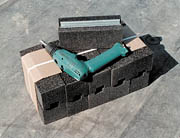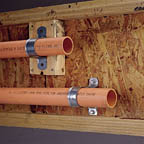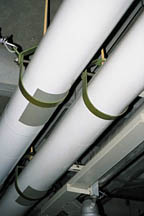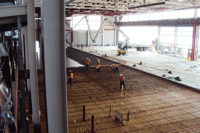If you are from a family that has historically worked in the plumbing and mechanical (P&M) industry, your grandfather no doubt had the same hanger and support product designs being used today. The P&M industry has experienced little innovation for hangers and support products over the last few decades.
However, in recent history, manufacturers of fastening support systems for the electrical industry realized the opportunity to design new, useful fastening alternatives for plumbing and mechanical applications. While the codes and standards of the electrical industry are different than those of the P&M industry, pipe is pipe. One pipe has fluid; the other pipe has wires. Both need to be attached and secured to meet industry standards, which should be done in the most efficient, cost-effective way.
As each trade bids on projects, the typical material costs are the level playing field. Everyone has figured out how to get the lowest price for materials. The opportunity to win projects now is by minimizing the labor. In fact, newer technology, which includes hangers, can increase (yes, increase) the material cost but net a lower installed cost for the project. Engineers and contractors who keep up with labor-saving technologies will keep their businesses healthy and profitable. With the checks and balances provided by the codes, standards, inspections, etc., the engineer is typically not to be concerned with installation products and techniques. However, many discern the benefits of visualizing, planning and specifying right down to this level. Improved efficiencies in hanging and supporting P&M components are no longer left to the contractor to figure out.
The engineer is playing a bigger role in specifying labor-saving products with benefits for all, including:
- More profit for the design and construction team.
- A lower installed cost for the owner without sacrificing system integrity.
- Meeting (or accelerating) project schedules.
Now, let's take a pseudo-field trip for busy engineers who find it increasingly difficult to visit job sites. You may or may not be aware of the typical hanger and support challenges the contractor deals with. The following examples will demonstrate the benefits of utilizing new innovations in "low-tech" hangers and supports.

Rooftop Applications
Problem(s):Not many would look at a 4" x 4" wood block as an engineered support solution for a pipe or equipment. Yet this is what the industry has had to use for decades. In fact, many specs call for "a wood block" in so many words. To protect the roof membrane from the abrasive movement of the hard block due to expansion and contraction of the system, a piece of foam material is often glued to the bottom of the wood. Sometimes the foam will wear away, and one of two things can happen: 1) the pipe or equipment will sag, and the wood will begin to wear away at the roof membrane, or 2) the wood block will no longer support the pipe and will hover above the roof (see Figure 1). The sag or strain can eventually cause system integrity problems due to broken connections and fittings.Wood will also split due to weather extremes. Most of the time, the wood splits where a nail or screw has been used to attach a one-hole strap, perforated strapping material or a section of strut channel. The split loosens the supports, and it is a common sight to see the wood block lying a few feet away from the pipe.
Now visualize what is typically unaccounted for in time and cost of the installation. ABC Mechanical sends "Installer Joe" to the local DIY store or wood supply center to get heavy, bulky 10' lengths of 4" x 4" lumber. Joe then needs to get a power saw, power outlet and set up to be a carpenter. Oh yeah, now we need foam, a knife and glue?nother trip to the store. Hopefully, Joe remembers to pick up the hardware, too. Now we make a few "one-handed" trips up a 40-foot ladder carrying a few blocks at a time, or set up a hoisting system that we hope does not damage windows in the process of pulling up the swaying, heavy blocks. The unusual visit of a project estimator reveals why they are a day behind the planned schedule and why they need to build in more labor units to future job estimates.
Another consideration for roof applications is the large loads that may require welding to the building structure. Welding is an expensive process, and a retrofit project also means added expense for the removal and replacement of the membrane.
Solution: A few manufacturers have introduced various pillow block designs for roof applications. Some are hybrids of hard plastic with a foam bottom, but the same potential problems can occur as with hard wood block with field-affixed foam. One of the best solutions now available incorporates a closed-cell polyethylene, UV-resistant foam block with bonded pre-galvanized strut (such as ERICO's Pipe Pier product). For most piping applications, 4"H x 4"W x 10"L blocks are available as 10-pack/10-pound bundles that can be easily carried up the ladder with one hand (see Figure 2). Six-inch-high blocks are readily available for gas piping applications to comply with the Uniform Mechanical Code 1312.2. (UMC 1201.1.6.2 for hydronic piping.)
The design permits a soft, pliable (but still firm support) barrier between the piping/equipment system and the roof. The cushioning surface accommodates expansion and contraction of piping.
Some of these foam blocks are designed to support up to 50-lb. loads at a 3-to-1 safety factor. Larger loads can be addressed with multiple foam blocks or by utilizing a design for 150-lb. or 300-lb. loads. These incorporate load distribution plates to minimize the footprint and may also be combined to support loads well over 1,000 lbs. They can support whatever the roof structure can.
Now engineers can specify an engineered solution for increased system integrity, prolonged roof life and minimal installation time, making projects more profitable.
Problem: Wood blocks can also be an inefficient way to make standoff spacers or backup blocks for CPVC fire protection piping on structural or composite wood joists.
Solution: Very simply, a two-hole standoff strap hanger positions the CPVC pipe 1-1/2" off the surface and is available for 3/4" through 2" pipe. It passes the UL203 test criteria and complies with the static load requirements of NFPA 13 (see Figure 3).
Problem(s): Strut hardware and components traditionally arrive in pieces that can be cumbersome to handle and can be dropped from ladders.
Solution(s): Several one-piece designs have become available that can minimize handling, searching, matching, assembling, etc. One such design incorporates a strut nut with an integral washer, so there is no need to match up the right depth strut with the appropriate length spring nut. One-piece clamps for back-to-back strut applications can be an alternative to using nuts, bolts and washers, as well as welded strut. And one-piece pipe straps for strut have been designed with a retained bolt and "built-in nut."

Purlin Application
Problem(s):Purlins (C & Z) are very often at a pitch following the roofline. When threaded rod drops are required, many drill the web of the purlin or use clamps that do not permit the rod to drop straight down. The installer improperly bends and muscles the rod into the direction he needs. The integrity of the rod has been compromised at the bend, and load values should be reconsidered.
Solution: A multi-flange rod hanger has been developed to work on purlins, I-beams and joists to eliminate the need for drilling. The hanger bypasses the upturned lip of purlins and properly loads the rod onto the building structure. The swivel allows straight drops of the threaded rod from pitched roofs without bending.

Beam Applications
Problem:While not typically viewed as a problem, the traditional heavy steel casting designs for beam clamps can be bulky and time consuming to install. In many applications, it may be overkill for the true load required.
Solution: Lightweight, heavy-duty, spring steel, hammer-on clamps for strap, rod and pipe have been used in the electrical industry since the 1960s and install in a fraction of the time that it takes for screw-on castings. Being smaller and lighter, more can be carried in the installer's pouch. Most engineers and contractors are pleasantly surprised with their load ratings. Some of these hammer-on threaded rod hangers have been tested to meet 800-lb. loads, which means they will handle a large percentage of daily applications.

Shielding Applications for Clevis Hanger/Insulated Pipe
Problem:A potential problem can occur despite the engineering spec to shield insulated pipe on clevis hangers. The clevis hangers get installed, a shield is set in place and the uninsulated pipe is laid on the "loose" shield. The insulation contractor lifts the pipe to put the insulation on. Sometimes, the shield is missing or not replaced/positioned properly (see Figure 4).
Solution: To ensure the shielding is in place, engineers should specify a clevis hanger with an integral shield.
